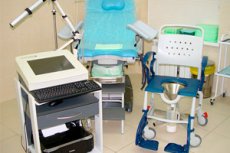Medical expert of the article
New publications
Urodynamic studies
Last reviewed: 07.07.2025

All iLive content is medically reviewed or fact checked to ensure as much factual accuracy as possible.
We have strict sourcing guidelines and only link to reputable media sites, academic research institutions and, whenever possible, medically peer reviewed studies. Note that the numbers in parentheses ([1], [2], etc.) are clickable links to these studies.
If you feel that any of our content is inaccurate, out-of-date, or otherwise questionable, please select it and press Ctrl + Enter.

Urodynamic studies are considered to be the main methods of functional diagnostics in urology. Their theoretical basis is the principles and laws of hydrodynamics. Registration and calculation of study parameters are based on this section of physics. It is generally accepted that urine movement (urodynamics) in the human body largely corresponds to the characteristics of fluid movement in various interconnected reservoirs. These include the cavity structures of the kidneys, ureters, bladder and urethra. Physical characteristics of urine movement are calculated taking into account that we are talking about a mobile, changing biological system, the imbalance of which, in the case of pathological changes, can manifest itself in various symptoms and a corresponding clinical picture. In this regard, the term "urodynamics" is often combined with the definition "clinical".
The main goals of clinical urodynamics
- reproduction of a situation with symptoms of urinary dysfunction;
- registration of objective characteristics of urodynamics in a convenient graphic and/or digital form;
- identification of pathological characteristics from the reproduced characteristics, thereby providing a pathophysiological justification for the symptoms;
- obtaining information to assess the characteristics of the course of the disease and the effectiveness of treatment.
The demand for urodynamic studies can be explained by the following paradox: "Knowing the type of urodynamic disorder, it is easy to determine the symptoms that correspond to it. To determine the clinical situation in the reverse order - to understand the type of urodynamic disorder by the symptom - is often extremely difficult." Symptoms are deceptive and ambiguous. Their incorrect interpretation leads to unsatisfactory treatment results. For example, with a symptom of difficult urination, it is difficult to judge what has disrupted urodynamics: obstruction of the neck of the bladder, obstruction at the level of the external sphincter or weak contractility of the detrusor? Only urodynamic studies can answer this question. In this sense, urodynamics is often compared with electrocardiography (ECG), without which it is almost impossible to determine the type of cardiac disorder and register it in a reproducible form. The ability to repeat studies allows you to compare indicators and evaluate the effectiveness of treatment (conservative or surgical).
The need to objectify urinary symptoms has been around for a long time. The history of attempts to study the urodynamics of the lower urinary tract based on knowledge of hydrodynamics begins in the mid-1950s, when Von Garrelts described a simple device for measuring urine flow over time. Later, Enhorning, Smith, and Claridge studied the possibility of measuring intravesical pressure and urethral resistance using pressure sensors. In 1970, Warwick and Whiteside suggested comparing urodynamic studies with radiological studies, and Thomas supplemented them with electromyography (EMG) of the pelvic floor. The first publication on standardization of urodynamic terminology belongs to Bates et al. (1976). Significant contributions to the development of urodynamic studies were made by N.A. Lopatkin, E.B. Mazo, A.G. Pugachev, E.L. Vishnevsky, and many others.
Further improvement of urodynamic technologies was facilitated by computerization, which helped to create databases, standardize studies in detail and led to maximum reproducibility of urodynamic studies.
Based on various criteria, urodynamic studies are distinguished:
- upper and lower urinary tract (by level);
- adults and children (depending on the age of the patients);
- men and women (by gender);
- mandatory and optional (according to the place in the examination algorithm for a certain disease);
- invasive and non-invasive (with or without the need for urinary tract catheterization);
- inpatient and outpatient (depending on the location);
- simple and combined (by the number of measurement channels and combination with other methods).
Urodynamic studies consist of components, each of which is a complete and independent diagnostic unit.
- Uroflowmetry (UFM).
- Filling cystometry.
- Emptying cystometry (pressure/flow ratio study).
- Study of the function of the urethra ( profilometry of intraurethral pressure).
- EMG. Conducted in combination with UFM and cystometry.
- Videourodynamic examination (a combination of urodynamic and X-ray examination, less often ultrasound).
- Outpatient monitoring.
- Neurophysiological tests (as an addition).
Depending on the indications, the necessary studies are selected from the list. The scope of studies is determined by a specialist in urodynamic research, in most cases during a preliminary consultation, less often - during the study itself.
In its classical form, the conclusion of a urodynamic study consists of a graphic display of the indicators of each of the components, digital characteristics, and a written conclusion from a specialist.
What tests are needed?

